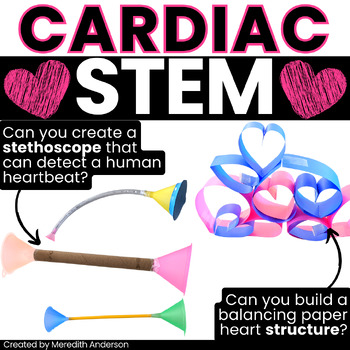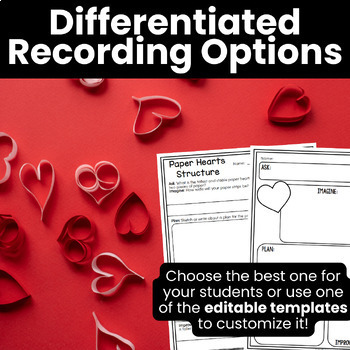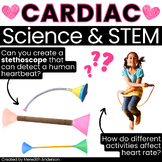Valentine's STEM Activities with ❤️ Hearts ❤️ Cardiac STEM Challenges
Meredith Anderson - Momgineer STEM Activities
14.7k Followers
Grade Levels
1st - 6th
Subjects
Resource Type
Standards
NGSSK-2-ETS1-2
NGSSK-2-ETS1-3
NGSSK-2-ETS1-1
NGSS3-PS2-1
NGSS3-5-ETS1-3
Formats Included
- PDF
Meredith Anderson - Momgineer STEM Activities
14.7k Followers
Also included in
- Looking to explore the circulatory system with your students? Try some hands-on science and STEM activities! I recommend completing the stethoscope STEM challenge FIRST so that students can use their stethoscopes to measure heartbeat for the science experiment (as long as students are comfortable usPrice $6.00Original Price $8.00Save $2.00
Description
Try these Valentine's day heart-themed STEM challenges with your students! They will create a stethoscope to hear a heartbeat (or sound through earbuds or a speaker) and a paper heart tower that is easy to set up but tricky to master. Students will need to use trial and error as well as balancing skills to craft this tower!
❤️ What You'll Get ❤️
- Teacher instructions and lesson plan
- Differentiated recording page options that guide students through the engineering design process, including editable options
- 2 STEM activities: stethoscope challenge and heart tower challenge
- Science reading passages with follow-up questions: The circulatory system, the human heart, and heart monitor devices
- Creativity challenge: Complete the Drawing activity
- 3 rubric options
✂️ Materials Needed ✂️
- wide straws- cardboard tubes, and plastic funnels (plastic tubing is optional)
- balloons (optional, latex free)
- paper
- tape
Total Pages
Answer Key
Rubric only
Teaching Duration
2 hours
Report this resource to TPT
Reported resources will be reviewed by our team. Report this resource to let us know if this resource violates TPT’s content guidelines.
Standards
to see state-specific standards (only available in the US).
NGSSK-2-ETS1-2
Develop a simple sketch, drawing, or physical model to illustrate how the shape of an object helps it function as needed to solve a given problem.
NGSSK-2-ETS1-3
Analyze data from tests of two objects designed to solve the same problem to compare the strengths and weaknesses of how each performs.
NGSSK-2-ETS1-1
Ask questions, make observations, and gather information about a situation people want to change to define a simple problem that can be solved through the development of a new or improved object or tool.
NGSS3-PS2-1
Plan and conduct an investigation to provide evidence of the effects of balanced and unbalanced forces on the motion of an object. Examples could include an unbalanced force on one side of a ball can make it start moving; and, balanced forces pushing on a box from both sides will not produce any motion at all. Assessment is limited to one variable at a time: number, size, or direction of forces. Assessment does not include quantitative force size, only qualitative and relative. Assessment is limited to gravity being addressed as a force that pulls objects down.
NGSS3-5-ETS1-3
Plan and carry out fair tests in which variables are controlled and failure points are considered to identify aspects of a model or prototype that can be improved.






